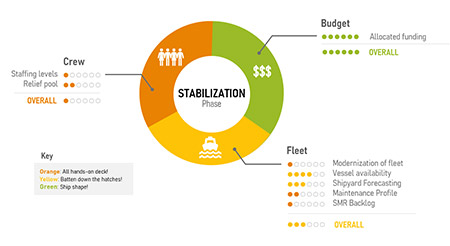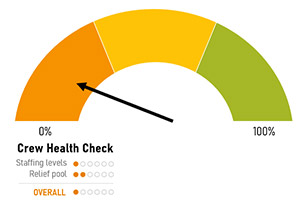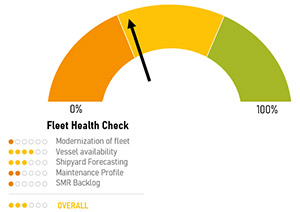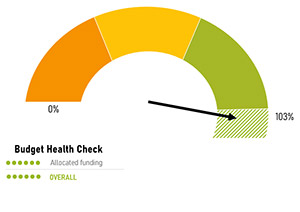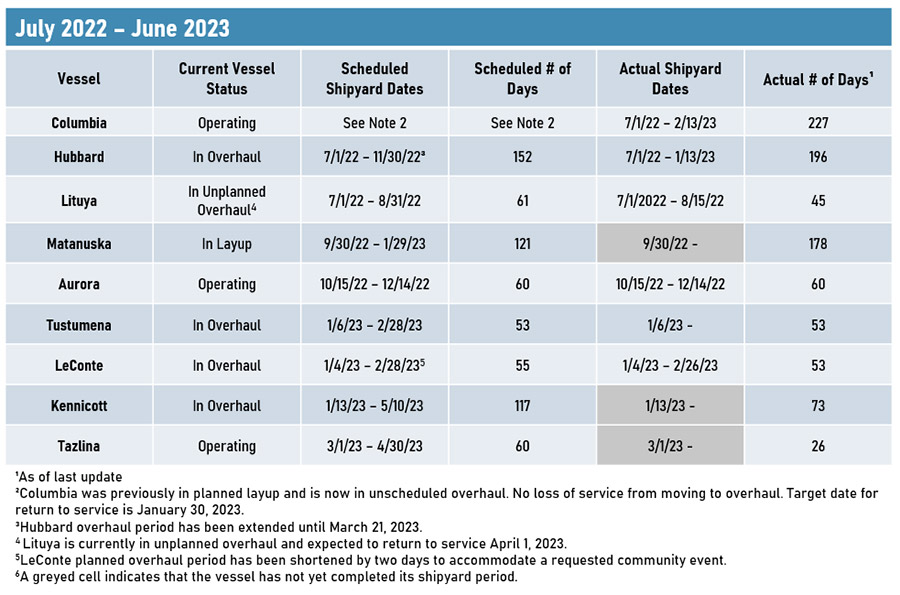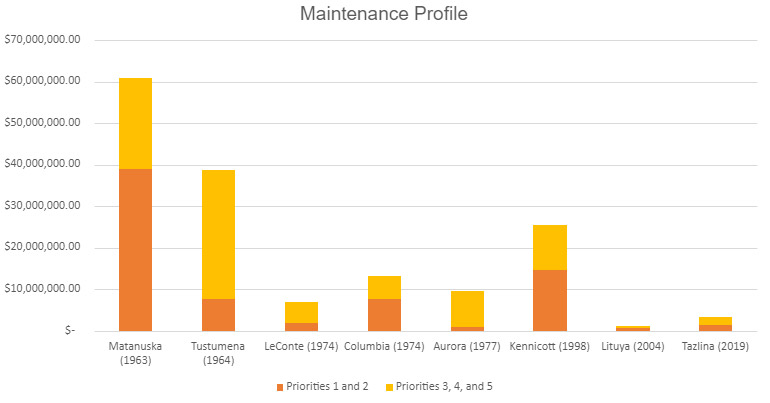Charting the Course
Public Comment:
Email a Comment
Like many agencies in Alaska and the nation, DOT&PF is facing unprecedented challenges such as workforce shortages, aging fleet, and supply chain issues. DOT&PF has been working to adapt to these dynamic challenges and continues to work toward reliable and predictable service as we develop the AMHS 2045 Long-Range Plan.
In October 2022, DOT&PF launched the Charting the Course | Reimagining AMHS Program to guide the system
towards a thriving and healthy transportation system. The program's primary focus has been on stabilizing the
system while providing transparency through monitoring and reporting of critical system elements - our crew, our vessels, and the financial resources to support service.
The dashboard below will give you a glimpse into the health of the system and its progress toward improved
overall health.
DOT&PF will continually monitor and periodically report on system health metrics in the three critical system elements of crew, fleet, and budget. Combined these metrics provide a system health check, and as service levels are improved, system health checks will continue on a regular basis to ensure that incremental improvements in the level of service do not negatively impact the reliability of the system as a whole.
Supporting our communities is critical to AMHS. As a result, mitigating measures will be implemented to help support our communities until the system reaches Full Steam Ahead status. These mitigating measures will fall into three main categories: Fares, Communications, Policies.
We are excited to embark on this new journey with you and look forward to building trust. We will be reaching out again soon with more information as the Program progresses.
SERVICE AREA COMMUNITIES
AC - Aleutian Chain
Chignik, Sand Point, Cold Bay, False Pass, Akutan, Dutch Harbor
KI - Kodiak Island
Cordova, Seldovia, Homer, Ouzinkie, Kodiak, Port Lions
PWS - Prince William Sound
Whittier, Cordova, Valdez, Chenega Bay, Tatitlek
CG - Cross Gulf
Yakutat
NLC - North Lynn Canal
Skagway, Haines, Juneau
NIP - Northern Inside Passage
Juneau, Gustavus, Hoonah, Tenakee Springs, Angoon
SIP - Southern Inside Passage
Ketchikan, Wrangell, Petersburg, Angoon, Juneau, Pelican, Sitka, Kake
MET - Metlakatla
Ketchikan, Metlakatla
YPR - Prince Rupert
Ketchikan, Prince Rupert
BEL - Bellingham
Ketchikan, Bellingham
Having trouble identifying which playbook to reference? Please refer to the system key below.
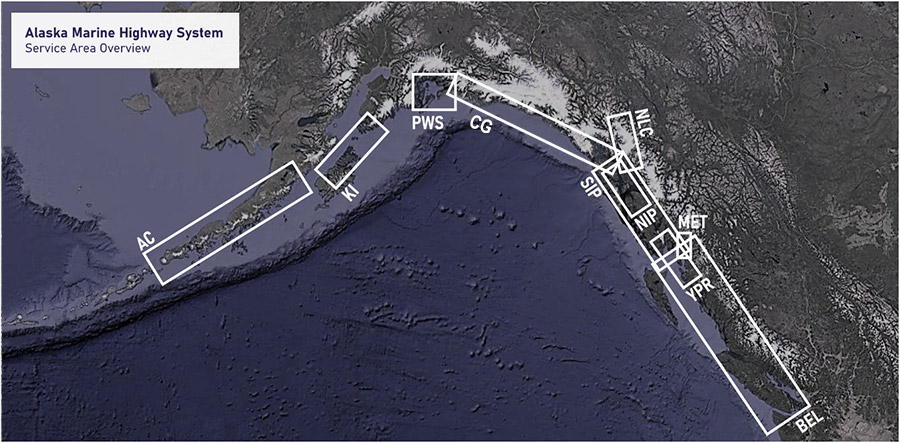
ABOUT THE PROGRAM

Building Trust One Trip at a Time.
The Reimagining AMHS program is a phased effort to improve service over time, focusing first on increasing the reliability of existing services and then moving to add additional services as critical system elements are available. The program aims to meet service level targets over time, as established by the legislature and Governor. These targets are based on crewing availability, fleet capacity, and budget constraints. Throughout the program we will continue to develop, monitor, and report on system health and progression. Three logical service phases have been identified as a part of the program: Stabilization, Recovery, and Full Steam Ahead.
What are the Phases of Service?
-
Stabilization: In this phase, important metrics that impact the level of service have been identified, and an initial system health check was performed by gathering a baseline for these metrics. Using this baseline, system health is continually monitored to inform operating decisions. This phase will include weekly/frequent updates to the public updating them on these important metrics.
-
Recovery: In the recovery phase, system improvements begin to take hold which has a positive impact on system health and service levels. Public updates will develop into a regular pattern, but less frequent than in the Stabilization phase.
-
Full Steam Ahead: By this phase, services will be restored to their budgeted levels, and the system can move towards growth. Updates to the public will be provided as needed to communicate ongoing progress.
BUDGET
AMHS's operating budget is based on legislatively approved service levels. In recent years, the system has seen reduced revenue due to loss of ridership and other services. Simultaneously, contracted crew levels and vessel availability have made it challenging for AMHS to scale up service levels to appropriate levels. Because of this, current funding levels are sufficient to support current service levels and the 2022-2023 Operating Plan. As service levels are improved, this system's health element will be monitored.
We will identify metrics that help us measure whether funding levels are adequate to support current and targeted service levels. We will evaluate whether the budget is sufficiently allocated to key operational areas, such as service and maintenance.
ALLOCATED FUNDING
It is important that allocated funding levels are sufficient to support the winter schedule and operating goals of AMHS. Funding levels will be assessed to determine if additional service can be provided. As the Reimagining AMHS plan progresses, funding levels will be compared to actual spending levels for Crew and Fleet.
CREW
Our dedicated, flexible, and hard-working personnel are the reason we have been able to maintain the service that we do. A tightening labor market and accelerated attrition after the onset of the COVID-19 pandemic have compounded longstanding challenges with hiring and retaining our people. We want to reverse these trends.
We will continue to benchmark current crewing levels against target thresholds and the minimum level required to operate each vessel in our fleet.
Relief Pool
Our current system is experiencing an overall shortage across the system with no relief for deck and engine personnel. As we reimagine our system, a 20% relief level will be targeted in order to adequately staff out system's vessels. Minimum crewing levels do not account for overtime worked.
FLEET
This key system health element is intended to measure the "State of Good Repair" of the fleet. The short-term operating needs of the system must be balanced against necessary maintenance and overhaul projects to ensure vessel availability over time. Both vessel utilization and "State of Good Repair" are considered in the overall health check. Currently, the fleet is aging and behind in vessel maintenance. This is a liability to the ability of the system to provide an adequate level of service. Five out of the nine vessels in the fleet are at least 45 years of age, and the fleet size has decreased in recent years as vessels have been sold or otherwise decommissioned.
The varied operating environments across the different service areas in the system mean that vessels are not easily transferrable to alternative routes of service. This means a single vessel being out of service increases the risk that the system will not be able to provide service to a community if a vessel goes out of service. This reinforces the importance of maintaining a "State of Good Repair."
Modernization of Fleet
As a vessel ages, the time required for maintenance and the likelihood of unexpected maintenance needs increases. These factors lead to disrupted service. See the graphic below to see the lifespans of our AMHS vessels.
Maintenance Profile
Fleet Condition surveys are performed annually with recommended maintenance listed by priority. Priority 1 items are those deemed most critical to vessel health and Priority 2 items less critical. Tracking maintenance priority levels provides insight into the condition of each vessel and captures trends of overall fleet maintenance.
FAQ
1. How does our service area track progress and use the Service Area Playbook?
To enhance transparency and communications, each community will be able to track service updates, program progress, and any changes to mitigation measures via a customized Service Area Playbook. Each playbook identifies the communities within a given service area, details important community events, and shows current gaps in service along with target service levels and the vessels compatible to serve those areas. Communities are able to provide comments and feedback to DOT&PF via the Service Area Playbook platform.
Overall, the Service Area Playbooks will be designed as a tool for DOT&PF to plan with communities and make decisions about how best to deploy additional resources (crew and vessels) to improve the overall health of the system. Service Area Playbooks will be updated regularly as DOT&PF evaluates resources and system metrics to determine if service levels need to be altered given available resources.
2. What immediate mitigation measures are being deployed?
Fares- Starting with the 2022 winter schedule, all fares now follow a flat rate pricing structure as opposed to the previous dynamic pricing structure.
Policies- DOT&PF is establishing a formal policy for supporting alternative travel options during disruptions. This will include subsidizing alternative travel for those communities where ferry service is below what could be considered essential.
Communications- Efforts will be made to modernize communications both on and off the vessel. Real-time text message updates will be developed to communicate where vessels are, and ship Wi-Fi will be installed for crew first, then expanded to passengers.
ENGAGE
Please engage with our team on the Reimagine AMHS Program. By providing your contact information, including email and phone number, AMHS can keep you up to date on service area schedule changes, system health updates, or opportunities to comment.
Share your thoughts with us!
Click the 'Email a Comment' button below to send questions, comments, or feedback.
Charting the Course
Public Comment:
Email a Comment
